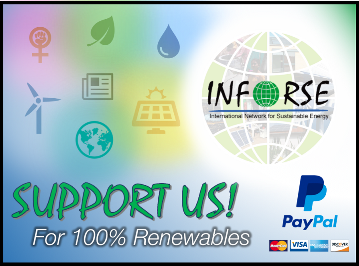|
|
|
|
|
|
|
|
|
|
|
|
|
|
|
|
|
|
|
|
|
| Follow Us: |
|
The Clean Development Mechanism - CDM
by Asger Garnak |
|
| INFORSE will give special attention to the CDM. In this article, there is a short overview of the CDM and NGO reflections on it as we know them at the INFORSE Secretariat by August 1998. More detailed NGO comments are available from the INFORSE Secretariat; contact person: Asger Garnak. | |
| Kyoto Protocol | |
| So far, the officially agreed-upon definition of the CDM is article 12 of the Kyoto Protocol. Main points are: The CDM deals with projects in developing countries in which emission reductions can be counted towards the emissions budget of industrialized countries. Reductions in emissions should be additional to any that would occur in the absence of the certified projects. A share of the proceeds from certified project activities shall be used to assist developing countries that are particularly vulnerable to the adverse effects of climate change to meet the costs of adaptation. The CDM shall be supervised by an executive board set up by the countries. CDM projects are subject to whatever guidance may be provided by this executive board. Certified emission reductions in the period 2000-2008 can be applied towards compliance in the first commitment period (2008-2012). | |
| Greenpeace: | |
| CDM is one of the loopholes in the Kyoto Protocol. It will inflate the emissions of the industrialized countries. Rules covering the CDM should place a quantitative limit on its use in order to ensure that domestic action is the priority. CDM projects should be limited to renewable energy or energy-efficiency projects that are at the top end of energy practice in the world. Because of the uncertainty associated with certifying emission reductions, only a part of the reductions should be added to the emissions budget of industrialized countries. A strong and independent CDM executive board should be formed. The board should be separate from other development entities such as the World Bank, and should have a composition reflecting North-South equity. | |
| ENDA, Senegal: | |
| CDM should balance the interests of industrialized countries with those of developing countries. The focus should be as much on ensuring sustainable development as on establishing a mechanism for cost-efficient emissions reductions. Activities Implemented Jointly (AIJ) arouse concerns that Africa might effectively be left out of the CDM process, since only one out of 75 AIJ pilot projects is being implemented in Africa. To include Africa CDM must: Function on a multilateral basis (i.e. not just country to country) Give attention to avoided future emissions. Stimulate development of the nascent markets in developing nations. Support the development of both organizational and technical infrastructure. Operate according to an explicit set of criteria that prioritize sustainable development. | |
| Climate Network Europe - CNE: | |
| There should be a limit on the fraction of emissions reductions that industrialized countries can get through the CDM. Trading certified emission reductions (CER) should not be allowed; The CDM must be additional to official development assistance and to the development of accelerated technology programs according to article 4.5 of the Climate Convention. The CDM must also be additional to the necessary integration of GHG accounting into all future programs of multilateral development banks; The CDM should only consist of renewables (excluding large hydro) as well as demand-side and cogeneration project activities. CDM activities should be compatible with overall national developmental and environmental priorities. Host countries should prepare strategies in advance that identify the role and opportunities for CDM technologies. The executive board should be independent and with a clear mandate. Southern countries should be over-represented on the board. | |
| West Coast Environmental Law Association, Canada (Chris Rolfe): | |
| One of the main weaknesses of the Protocol is that, under CDM, credit is likely to be given for projects that would have occurred in the absence of the mechanism. The best way to mitigate this problem is to establish stringent criteria for setting the baselines against which emission reductions are measured. | |
| Center for Science and Environment (CSE), India: | |
| CDM is riddled with moral and other loopholes. CSE questions the underlying assumption that it is cheaper to reduce greenhouse-gas emissions in developing countries than in developed countries. It also warns developing countries of the problems with “selling” the cheap reduction options to developed countries, leaving more expensive options for future agreements on emission reductions. | |
| Further issues important to INFORSE: | |
| A narrow project approach tends to ignore the often far greater importance of framework conditions such as macro- and sector policies. There is a real risk that the project-based CDM will favor such a narrow project-approach, which is generally considered outdated and ineffective. It must be ensured that framework conditions, market development, and capacity-building are addressed in a way that complements the project focus of CDM. A central issue is whether the CDM will be designed in a way that is compatible with the practices and priorities of NGOs, i.e., taking a bottom-up approach that centers on local participation. Traditionally small-scale projects give high transaction costs for donor organizations. As a result these organizations tend to prefer large-scale (and often conventional) projects. The costs of project certification can further place locally based, small-scale projects at a disadvantage. | |

| |
| Published in Sustainable Energy News |
|
|
Go back to main page of ISSUE #22, Sustainable Energy News (16 pages) (1998-09-01) |
|
| Contact | |
| |
INFORSE Secretariat Klosterport 4F, 1. floor DK-8000 Aarhus C Denmark Phone: +45 86 22 70 00 Twitter: INFORSE_org Facebook: INFORSE Web: inforse.org E-mail: ove@inforse.org |
